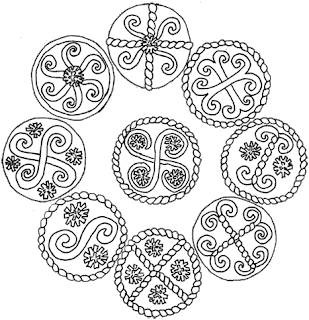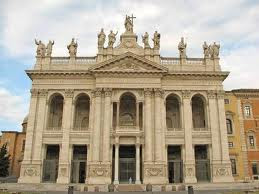In 2009 I posted
about Festive Easter Breads and Cheese. My cookbooks are full of margin notes, so I thought I would update my notes on the recipes. This is crossposted with my food blog,
Family Food in Feast and Feria.
We enjoy spreading
Pascha, the Easter Sweet Cheese Mold on the
Paska, just like in one of our favorite children's books,
Rechenka's Eggs by Patricia Polacco. At first I was a bit confused, as the name for the dessert cheese is Pascha (or Pashka), very close to the Ukrainian name for the bread. And “Pascha” is the Orthodox name for Easter. Once I got the names sorted out, I was convinced I had to try the cheese. I didn’t have an “official” mold, so used the clean clay unglazed flowerpot. Be sure to make ahead (the recipe says 2-3 days. Wednesday or Holy Thursday is probably the latest). I omit the candied fruit and the almonds, as I want a smoother, creamier texture. My husband always requests this so I have been working on improving this every year.
The recipe I use is from
A Continual Feast: A Cookbook to Celebrate the Joys of Family and Faith Throughout the Christian Year by Evelyn Vitz. I’ve had the pleasure to meet her and some of her daughters (and even go on retreat with her and her daughter in law this month!). But I digress…
This is an absolutely beautiful and delicious dish; versions are prepared in Poland, Russia, the Ukraine, and Latvia. It is made in a tall mold (or flower pot), then turned out onto a large platter and decorated. Cool and rich, it tastes like a cross between ice cream and cheesecake. It goes wonderfully with other the sweet Easter breads, such as Kulich, or
Paska Or
Easter Sweet Bread or with various Easter cakes.
There was some discussion of the "farmer cheese" from the previous post. This is a more difficult ingredient to find. My grocery store carries this, the brand is "
Friendship", but you can try ethnic grocery stores. Some people have had success with Mexican
queso fresco. It is NOT an aged hard cheese, but a soft and crumbly, almost like ricotta, or a softer version of feta. It is usually found near the yogurt, cottage cheese and/or sour cream, but not in the cheese section
. If you cannot find farmer's cheese and need to use large curd cottage cheese or ricotta, rinse the cheese with cold water and drain well in a fine colander. Ricotta might need to just be drained. Then take a fine mesh strainer and press the cheese through to make it finely sieved and ready to mix.
I’ve had trouble over the years having the mixture drain well so it becomes firm. Last year was my most successful year. The flowerpot that works well for me is an 8″ clay flowerpot. But I have found the shorter and wide flowerpot drained better than the tall pot. The picture below shows the two 8″ pots, but the one on the left is the one I use for both the
bread Paska and the cheese spread.
These are just clay pots made in Italy that I found in my local gardening store. I cleaned well before using.
After covering with cheesecloth, I place a small plate on top, then used a weight (literally, one or two of my husband’s free weights) and then put the pot in a large bowl. Last year the bowl was shaped that the pot was suspended above a few inches, instead of flat on the bottom. This allows more draining.
For decorating I just keep it simple. And face it — no matter how beautiful the presentation, after one small serving it never looks "pretty" again. But that doesn't matter, because it is super delicious and everyone will keep coming back for more.
Pascha
1 whole egg
4 egg yolks
2 1/3 cups sugar
1 cup heavy cream
2 pounds farmer cheese (see comments)
1/2 pound sweet butter, at room temperature
1 tablespoon vanilla extract
1 1/2 cups fruit: raisins and/ or dried currants, mixed candied fruit peel (I omit)
1 cup blanched almonds, chopped (I omit)
2 tablespoons freshly grated orange or lemon rind (I use both, enough zest from one orange and 1 lemon)
For decorating:
Candied fruit peel, maraschino cherries, or nuts
Fresh strawberries to place around the base and on top
Beat the egg and the yolks until thick and lemon-colored. (NOTE: Using a stand mixer, this is about 5 minutes.) Gradually add the sugar, and beat until the mixture is thick and creamy. Pour into a saucepan and add 1/2 cup of the cream. Heat over medium-low heat, beating constantly, until the mixture begins to thicken. Do not boil. Remove the pan from the heat and continue beating until the mixture has cooled to lukewarm.
(NOTE: I use a wire whisk to beat while heating. I have a gas stove, and using fresh cream from the farmer the mixture is already very thick. On the heat this takes about 10-15 minutes. You will know it's getting thicker when you see the sugar dissolving. At the beginning it's very grainy. After removing from the heat I either put back in the stand mixer and just beat until cooled to lukewarm, or keep in saucepan and stir with the whisk. I don't do it constantly, but very regularly, while I'm beating the other ingredients.)
In a mixing bowl, combine the cheese, butter, the other 1/2 cup of cream and the vanilla. Cream until the mixture is smooth. Add the egg mixture, then the fruits, almonds, and orange or lemon rind. Blend thoroughly. (NOTE: At this point the mixture is very soupy.)
Line a flower pot or Pascha mold with 2 thicknesses of cheesecloth. Place the pot over a bowl (to catch liquid), and pour the Pascha mixture into the pot. Put a layer or two of cheesecloth over the top, set a plate on it and something heavy on the plate. (The purpose is to press the extra liquid out of the Pascha and into the bowl below.) (NOTE: After pouring into the mold, I put a plate and then weight it down. I gradually add more weights, my husband's free weights, after the mixture has chilled longer. Try to place a plate that covers the whole top. There will be oozing over. Do not panic.) Chill overnight or for a day or two.
Remove the top cheesecloth. Unmold the Pascha onto a large platter, and remove the rest of the cheesecloth.
Decorate the Pascha with the candied fruit peel or maraschino cherries or nuts to form the letters XB or CR (Christ is risen) on one side, and on the other side a cross. You may use the Western cross form or the Orthodox cross, or any other cross design that you prefer. In Russia, Pascha is often decorated with an angel and a lily, as well as the cross.
Around the base and on top of the Pascha, place fresh strawberries. Serve chilled.
Yield: 14 to 16 servings
The best part after making these goodies, was arranging the Easter basket for a blessing at our parish by the pastor. I included our Easter eggs, pysanky, ham, wine, butter lamb, paska and pashka. This year I bought a simple Easter basket cloth made by some Catholic ladies in Johnstown, PA, which I can't wait to use.
A blessing on the Paschal feast, and your celebration!























































